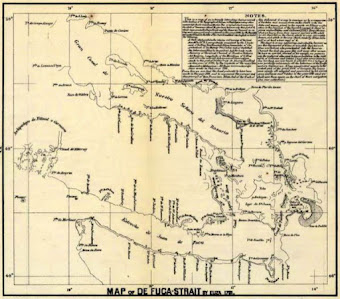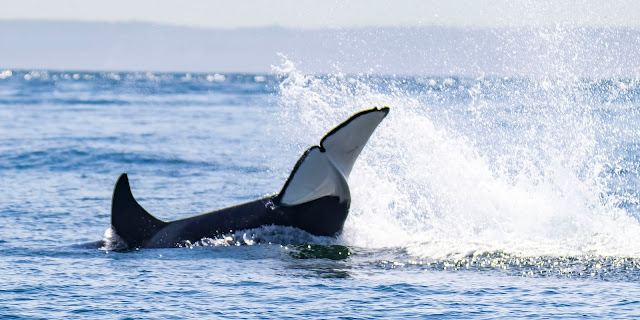 |
| Beautiful Friday Harbor on San Juan Island |
We were taking the Washington State Ferry to Friday Harbor, a town on San Juan Island, where we would be staying for three nights and going on three whale watches.
 |
| Friday Harbor Marina |
We didn’t want to leave anything to chance because we know that Orcas can be fickle critters. Practically every minute on the island would be whale-watching.
It was foggy in the morning when we arrived at the ferry terminal. We hoped this wasn’t foreshadowing for our visit to the island, but we knew that the Pacific often creates morning fog that dissipates into sunny skies.
 |
| Fog is common on the Pacific Coast |
While waiting in the ferry line, I observed and photographer a couple of birds – hampered a bit by very low visibility.
There were some close-by House Finches and Lesser Goldfinches …
 |
| Breakfast time for birds |
… plus a couple of Bald Eagles and almost 30 Great Blue Herons …
 |
| Eagle and Great Blue Herons; It was too foggy to photograph the 30 Herons on the beach |
Once we drove onto the ferry – one of the very large car ferries common in the Pacific Northwest, we went onboard to see what we could see from the deck.
 |
| The Washington State Ferry is a great way to get around |
Before we even departed, we observed a large number of Pelagic Cormorants that were nesting on the dock pilings.
 |
| Gathering nesting material from the sea |
These birds are slimmer and smaller than their cousins, the more-common Double-crested Cormorant.
 |
| There were dozens of them on the pilings |
I have seen them before, but was surprised at how iridescent they were, even in the watery sunshine that was trying to break through the clouds.
 |
| Really pretty birds |
You can recognize a breeding Pelagic Cormorant from the white patches on its back ...
 |
| Pelagic means "relating to the open sea" |
The trip from Anacortes to Friday Harbor took about an hour. We scanned the horizon, but didn’t see a lot except for some Moon Jellies …
 |
| We saw lots, but we zipped by so fast, it was hard to snap |
… flying Rhinoceros Auklets …
 |
| We'll get better views of these guys later |
... and fairly distant Black Guillemots ...
 |
| Not always graceful |
The San Juan Islands
An archipelago in the Salish Sea north of the Strait of Juan de Fuca between Washington and Vancouver Island, British Columbia, Canada, the San Juans are part of the state of Washington.
 |
| San Juan Islands |
 |
| A small island and the shoreline |
 |
| Remnants of native and European cultures at American Camp |
 |
| Eliza's map |
 |
| So, Orcas are actually named after the Viceroy of Mexico! |
 |
| Vancouver expedition; Painting: Captain Steve Mayo |
 |
| Wilkes' names honored War of 1812 heroes |
Wilkes, who may or may not have had charts with the Spanish names, gave decidedly American names to nearly every coastal feature.
In 1847, the British resolved naming issues in the areas under their dominion, including the San Juans, by keeping the British and Spanish names and removing the American ones. The areas under American control kept the names given by Wilkes.
That’s why the San Juans have many Spanish names, but the rest of Washington does not.
So, we had three parties exploring, charting and naming the area.
 |
| It would be easier to be like birds and ignore borders |
The 1846 Oregon Treaty had established the 49th parallel as the boundary between Canada and the U.S. west to the middle of the Strait of Georgia, and then by the main channel south to the Strait of Juan de Fuca and from there westwards to the open ocean.
Both sides agreed that all of Vancouver Island would remain British, but the treaty did not specify which channel the boundary should follow between the Strait of Georgia and the Strait of Juan de Fuca.
The U.S. claimed Haro Strait as the international border, while Britain claimed Rosario Strait, with both sides laying claim to the San Juans.
 |
| The Patos Lighthouse is on the American side close to the border |
So, even though some of the islands are north of parts of Canada, they are ours.
Natural Beauty
By the time we arrived at Friday Harbor, it was sunny. That's great, because the island is beautiful.
 |
| Ocean and mountains -- you can't beat that! |
The coastlines are a mix of sandy and rocky beaches, shallow inlets, coves, bays and deep harbors.
 |
| Kayakers in an inlet |
 |
| Lavender is a popular crop, which attracts a wide variety of bees |
 |
| Lots of flowers were blooming |
 |
| A Bald Eagle we saw on our first whale watch |
 |
| A pretty bird singing on a sunny day |
 |
| Fawn, 2012 |
 |
| Black Red Fox, 2012 |
Wolves, Elk, Sea Otters and Beaver used to inhabit the San Juans, but no more. However, Beavers may be making a comeback, swimming over from the mainland.
We didn’t see a lot on the island, but, then we didn’t spend much time ON the island. As I said, we participated in three whale watches in, essentially, a day and a half on the island.
On-Island Sights
When we weren’t on a boat, we briefly visited both parts of San Juan Island National Historical Park, also known as American Camp and English Camp.
 |
| English Camp sign |
Why was in called the “Pig War?”
In 1859, an American killed a stray British-owned pig, ignited already simmering bad blood between the two groups. The American homesteaders requested military protection, resulting in the establishment of the American Camp, while the British sent Royal Navy ships.
 |
| Map: NPS |
The British withdrew after the dispute was resolved and American Camp was reduced in size and scope.
We also went to Lime Kiln Point State Park where we looked for whales from a popular viewing area near the Lime Kiln Lighthouse.
 |
| Lime Kiln Lighthouse detail |
The Park is considered one of the best places in the world to view wild Orcas from a land-based facility.
 |
| In 2012, our whale watch went this close to the lighthouse (not cropped) |
At Lime Kiln, people on the shore can be within 20 feet of breaching Orcas. If they are lucky.
 |
| I took this in 2012 of Orcas right by the shore |
 |
| I have seen Harbor Porpoises many times before; this is my only decent photo |
 |
| Drifting in the inlet |
And, of course, we saw the pretty little Lime Kiln Lighthouse.
Now, I can’t talk about any location without discussing food. Eating out was a bit tricky because Friday Harbor was still under a full mask mandate and many places were operating at reduced hours.
Even though we were not super hungry (we had picnicked at Lime Kiln), we decided to get a bite to eat before our first whale watch and that was the best food decision we made.
We ate on the deck at Downriggers overlooking the harbor, so the ambiance was incredible.
 |
| Scott studying the menu |
We were hungry when we got back at around 8:30 p.m. after our evening whale watch, but only a handful of restaurants were open. Yes, a tourist town, where no restaurants are open after 8:00 p.m. We ate at the Blue Water Bar and Grill despite some rather sketchy online reviews because, well, it was open. I had “tomato basil soup” that looked and tasted like marinara sauce. Even a side of sour cream couldn’t tame it enough to make it palatable. I could not recommend that place.
 |
| Too bad there was no crab |
The place was pretty good (Caty and I had burgers, Scott fish and chips), but they didn’t have Dungeness crab, which is what Scott wanted. Apparently, Dungeness has a season. Who knew?
That evening we booked it back to Downriggers after the whale watch and just squeaked in before they closed. The food was just as good as before and the view as the sun was setting was spectacular.
We stayed at the Earthbox Inn & Spa (we didn't have time for spa; we never have time for spa), a nice little very conveniently located hotel right in the middle of town. They had been great about us cancelling our first planned trip, so we had to go there. It was a good choice.
But, enough about the island, that is not why we were there. Tune in next time to find out what happened on our whale watches.






No comments:
Post a Comment